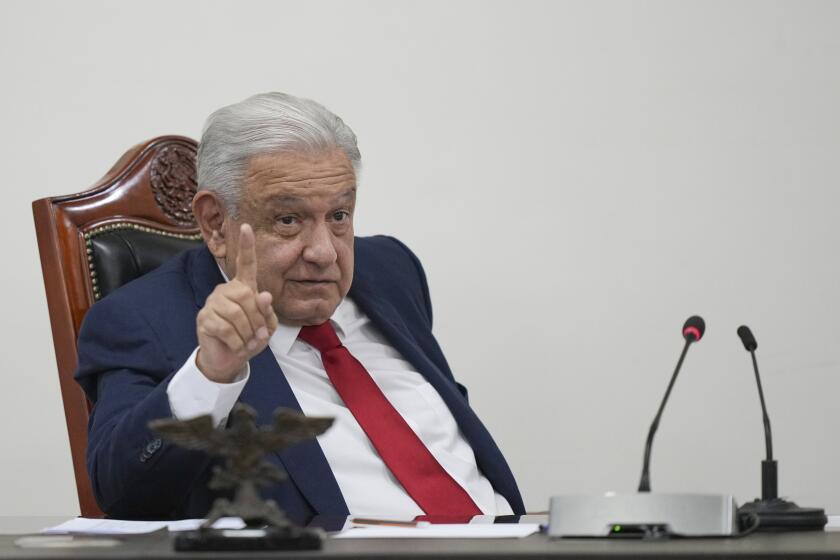Robin M. Williams Jr., 91; Sociologist Studied Race, War
Sociologist Robin M. Williams Jr. spent much of the 20th century studying questions that defined the times -- and the challenges -- faced by the nation.
In the 1940s, as World War II raged in Europe, Williams asked what motivated soldiers to fight. In the 1950s, as the civil rights movement reshaped the nation’s racial landscape, Williams surveyed whites in four U.S. cities about their relationships with African Americans. In the 1960s, he surveyed college students about their changing views. In 2003, during the aftermath of the Sept. 11 terrorists attacks, he studied peoples and states in conflict.
Williams, a seminal figure in American sociology who taught at Cornell University and UC Irvine and wrote more than 150 articles, monographs and chapters in edited volumes, died June 3 at Irvine Regional Hospital of pulmonary complications from surgery. He was 91.
“Because his life spanned nearly the entire 20th century, his work paralleled the development of the field of sociology, and in a way the development of the entire social sciences,” said Calvin Morrill, chair of the sociology department at UC Irvine. “He was a great empirical researcher and a great observer of social life.”
Over the years, Williams’ work would serve as an example of the progress the field had made, evidence of the role sociology can play in helping a society understand itself.
The son of a farmer, Williams was born in Hillsborough, N.C., on Oct. 11, 1914. At 19 he received a bachelor’s degree from North Carolina State College, now known as North Carolina State University. In 1935 he earned a joint master’s degree from North Carolina State and the University of North Carolina. By 30, he held a master’s and a doctorate from Harvard.
During World War II, Williams spent four years in the Army as a researcher, some of it literally on the front lines. As Allied troops fought in France, he observed soldiers, took notes and asked questions. Later, his observations became part of a seminal work, “The American Soldier: Adjustment During Army Life,” the first comprehensive study of the attitudes of combat infantrymen in war. Until then conventional wisdom had held that people fought out of patriotism or hatred of the enemy. The study reached a different conclusion.
“People fought to save their buddies, because of relational solidarity,” Morrill said. The study offered key findings that “essentially created the social science foundations for the way military infantry are trained.”
Back home, Williams’ work focused on schools and later on race. One of his studies was used by Thurgood Marshall’s team in preparing the case Brown vs. Board of Education, Morrill said.
“Williams was very important in ... really bringing the topic of race into the sociology of inequality in America,” said Philip Kasinitz, professor of sociology at City University of New York and president of the Eastern Sociological Assn.
In 1964 he published “Strangers Next Door,” a work based on eight years of study and interviews of residents in Bakersfield; Elmira, N.Y.; Steubenville, Ore.; and Savannah, Ga., that included such questions as “Would you mind eating with Negroes?”
The value of his work wasn’t always readily apparent at the time it was published. A 1964 Times review criticized the findings of “Strangers Next Door” as “disappointingly thin” and questioned its value.
But such work on race and ethnicity would remain a critical component of his research. Years later he was invited to co-chair the National Research Council’s Committee on the Status of Black Americans. He was co-editor of “A Common Destiny: Blacks and American Society,” a major work published in 1989 that is still widely cited.
Much of Williams’ early work was completed while he was a professor at Cornell University, his academic home for 56 years, including 18 as a professor emeritus. But in 1990 UC Irvine was building its sociology department and searching for someone who could help in the development and lend it legitimacy, said William Schonfeld, former dean of the School of Social Sciences, who now heads the Center for the Study of Democracy.
Schonfeld asked Williams to join the faculty. He accepted, and he and his wife Marguerite, whom he married in 1939, moved to Irvine. Williams is survived by his wife; two children, Nancy Elizabeth O’Connor of Santa Fe, N.M., and Susan York Williams of Binghamton, N.Y.; as well as a sister, Helen Coble of Mebane, N.C. A son, Robin M. Williams III, died in 1984.
In 2003, at age 89, Williams published “The Wars Within: Peoples and States in Conflict,” which includes observations about the fears that drive conflict, observations that resonate.
“The sensed threat takes many forms, both realistic and imagined,” Williams wrote. “The common form of ethnic fear is expressed in the language of being overwhelmed, swamped, deluged, dominated, becoming helpless and permanently disadvantaged ‘in our own land,’ and ultimately being exterminated.”
Such extraordinary scholarly contributions helped earn Williams membership in the American Academy of Arts and Sciences, the National Academy of Sciences and the American Philosophical Society, and leadership roles in many other professional organizations, Schonfeld said.
After years of examining hatred, greed and conflict, Williams turned the tables. He created an innovative class at UC Irvine called “Altruism and Cooperation,” which students loved, Morrill said.
“This is all at 91 years of age,” Morrill said. “He was an amazingly vital person.”
Once the youngest in academic circles, Williams found it ironic that he lived long enough to be the oldest. His longevity might have made him a good subject for one of the questions asked by researchers in 1950, when he was director of the Cornell Social Science Research Center. The study sought to determine the way retirement affected the length of a man’s life. Williams suspected that leaving work led to psychological disturbances that contributed to “the physical infirmities of old age.”
More to Read
Sign up for Essential California
The most important California stories and recommendations in your inbox every morning.
You may occasionally receive promotional content from the Los Angeles Times.










